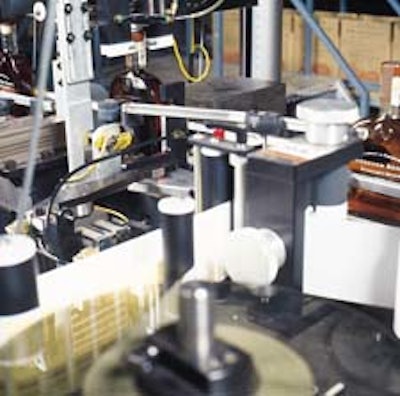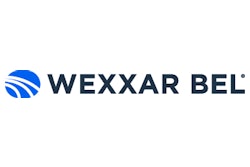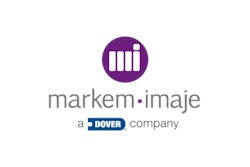
Labrot & Graham Distillers now ships between 800 and 1ꯠ cases a day when it produces its premium Woodford Reserve Distiller’s Select bourbon whiskey. That’s quite an improvement compared to its previous output of 200/day. Along with the output increase, the distiller also reduced its labor costs and turnaround time. How?
By employing a custom pressure-sensitive labeling system that includes five applicators to automatically apply a p-s label to the front, back, side, neck and over the cap of each glass bottle. Designed and manufactured by CTM Integration (Salem, OH), the labeling machinery operates at Labrot & Graham’s Versailles, KY, plant. Labrot & Graham is a subsidiary of Brown-Forman Corp.
Labrot & Graham was referred to CTM by label distributor MPI Label Systems (Sebring, OH), a distributor of CTM machinery. The new labeler was installed last year, as was: a “bar-top” corker from Bertolaso, an Italian supplier represented in the U.S. by fp Packaging (Napa, CA); a Belcor (Richmond, British Columbia, Canada) case taper; and a Markem (Keene, NH) case coder. Newer still is an ink-jet bottle coder from Willett America (Ft. Worth, TX). All this equipment runs on one line at the recently restored Versailles plant (see “plant renovation” sidebar, p. 41).
Bottles are filled on a refurbished rotary filler that operates at speeds of 25 to 29 bpm for 375-mL, 700-mL, 750-mL and 1-L sizes of Woodford Reserve. The premium brand was introduced in ’96. The company’s master distiller hand-selected bourbon “stock” for the brand, then set it aside for its seven-year aging process.
The operating rate makes it clear that speed isn’t a primary concern for this high-priced, low-volume product line, though that’s changing. Speed is further limited because the premium spirit is bottled from tank batches of no more than 1겨 gallons. Another factor: Running the filler at faster speeds would likely reduce filling accuracy.
What is a concern to Labrot & Graham is how efficiently batches can be bottled to meet orders, which grew to 18ꯠ cases last year. Trouble-free labeling of the bottles is how the CTM system earns its keep.
“In the past, we had a machine that applied cold-glue labels to the front and back of the bottle,” explains Dave Scheurich, plant manager and master distiller at Versailles. “Then we’d put those bottles in cases by hand, bring the cases to another work area, empty bottles from the cases and apply the other three labels to each bottle manually before placing the bottles back in the case.
“We double-handled bottle labeling because it’s important to first empty the filler and run the bottles for that batch,” he continues. “If you leave whiskey in the filler or tank for days on end, [evaporation can cause] the proof to drop below what the government allows, and then you’ve got a big problem,” he says.
Not only was the process labor-intensive, it was also messy. “The older labeler used a ‘jelly-gum glue’ that was cold and wet,” Scheurich recalls. “Glue would be transferred from one roller to another roller that applied it to the label. People would get glue on their fingers and sometimes transfer it to the surface of the bottle, and the bottle would have to be cleaned off. Quality-wise, hand-labeling left a lot to be desired, and the placement of the labels wasn’t always the same.”
Touring the line
“We receive pallet loads of bottles that are packed into reshipper cases upside-down so that when we hand-dump them, they’re right-side-up on a feed table,” says Scheurich. The reshippers are provided by the vendor of the custom glass bottles. (See materials sidebar on opposite page.)
The front of the bottle has the “LG” symbol molded in just below the neck, and an applied ceramic labeling (ACL) decoration below that. Both necessitate proper bottle orientation for downstream label placement.
Bottles are conveyed from the feed table four at a time, in single-file, onto a plastic, belted conveyor. A blast of air and vacuum are used to clean bottles before they reach what Scheurich describes as a nine-head rotary vacuum filler. When the fill level is reached, a vacum is drawn in the fill tube to prevent overfilling.
Between the filler and corker, the Willett machine applies an ink-jet code to the bottle’s front panel, near its base. The code includes a plant designation, Julian date, year, shift and military time.
After coding, bottles continue to the Italian-made Bertolaso Lambda 110 automatic bar-top corker. It applies a custom cork/wood closure. “We used to have someone on the line who would put a cork into a pneumatic plunger that plunged the cork down. Now it’s done automatically, with consistency and precision,” says Scheurich.
“It’s a one-station machine that serves the line well,” says Jens Lueken, manager of project engineering and the “equipment expert” for the line.
Three-station labeling
Each bottle moves through three stations to receive its five labels. They’re applied by five CTM Series 360 tamp applicators.
Bottles are conveyed into the labeling system upright, side first. As they move to the first station, they reach a custom product-handling system that’s equipped with what CTM calls an “escapement sensor.” The sensor detects a bottle, releasing bottles one at a time to a clamping system made up of three devices. The bottle’s leading edge contacts the first of these, a finger-like device. At that point of contact, the bottle stops, allowing two clamps to hold the bottle. One clamp contacts the bottle’s front panel, the other the back panel. Both clamps use rubber-coated rollers to prevent scuffing of the glass.
The first Series 360 applicator employs a custom-designed “swing-tamp” module to apply a “strip stamp” label over the cork and down two “sides” of the neck. The unique swing-tamp module uses a three-panel, split-vacuum tamp pad that conforms to the bottle’s neck to ensure a smooth, consistent tack to the bottle. All the applicators are stepper motor-driven, which CTM says permits greater label placement accuracy.
At the same station, a second Series 360 unit applies the second of the five labels, this one to the leading side of the bottle, near the finger device. Then the clamping station returns to its home position for the next bottle. The labeled bottle is then conveyed to the second labeling station.
At this station, two applicators are used to apply front- and back-panel labels near the bottle’s base. The front-panel label is applied above the bottle’s ink-jet code. After these two labels are applied, two “foam impressor” rollers contact the bottom two edges of the strip stamp label to make sure they’re well-tacked to the neck.
That’s important because once the bottle is conveyed to the third labeling station, the fifth and final Series 360 applicator applies a band label around the bottle neck that goes over the two bottom edges of the strip stamp label.
The neck label is applied at a custom wipe-slide assembly station that’s equipped with rollers that “hug” the bottle neck and follow it around 180° as the bottle travels along the conveyor. That completes labeling.
Savoring the benefits
Bottles exit the final labeling station single-file. Operators manually inspect them and hand-pack them into the reshippers, six/case for the three larger sizes, 12/case with the 375-mL size. “We can run the product all the way through the line and we’re done,” says Lueken. “We don’t have to repack the bottles and handle them twice as we had to before, which was extremely expensive labor-wise.”
Operators now close top flaps of the reshipper cases before they’re automatically taped shut by the Belcor BEL 252. A Markem ink-jet coder applies proof information, SKU, lot and date numbers to each case. Cases are manually palletized and stretch-wrapped. Scheurich points to four key benefits of the CTM labeling system:
• Higher production capability. “We produce two days a week now, at 1ꯠ cases a day, whereas once we filled maybe once every 10 days at 200 cases a day,” he notes.
• Labor savings. Scheurich estimates that labor savings are about $2.50/case. “Trying to calculate savings numbers is complex because we had temporary workers in to help label at whatever pace they could,” he explains. “There wasn’t a strict calculation for labels, because many of these people did other tasks by hand, as well. But with about the same amount of people, our output is four or five times higher than it was previously.”
• Quality and placement accuracy. “With a machine applying every label, there’s more consistency. They look straight and even,” Scheurich says.
• Improved order turnaround. Before adding the new equipment, “we had a 15-day turnaround time for an order of 3ꯠ cases, which is just not acceptable,” he says. “As our orders were getting bigger, we had to take steps to meet that demand.”
Orders continue to grow, Scheurich says. “We started in October four years ago with no sales and now we’re in 47 states and 25 countries, using the Brown-Forman distribution system.” He says the highest-volume bottle of Woodford Reserve, the 750-mL size, retails for around $27.
Forecasting the future
In the near future, he continues, “We hope sales will increase so we’ll need to use the line maybe three or four days a week. Eventually we’re going to have more tanks,” he adds, which would allow for greater output. For now, though, he’s pleased with the labeling upgrade.
“Labeling is absolutely the key to the line. We could have gone on corking bottles and sealing cases by hand, but there was no way we could label that many bottles by hand,” to meet growing orders. Scheurich says that, based on output, the labeling system will deliver a payback in less than two years.
See sidebar to this article: Simple but elegant materials
































